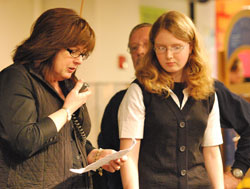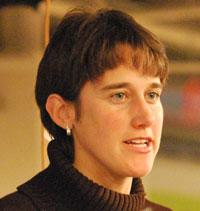To Infinity and Beyond

This live satellite image, showing the International Space Station's orbit, was projected onto a screen at the Hands-On Museum. The concentric circles indicate the range for radio contact with the ISS. (The map also appears to confirm that Ann Arbor is indeed the center of the universe.)
When The Chronicle arrived at the Ann Arbor Hands-On Museum Saturday morning, Ig Justyna was on the roof adjusting a directional antenna – when they say “hands on,” they aren’t kidding.
Justyna was the main organizer of Saturday’s link-up with the International Space Station, giving kids a chance to ask questions of the flight commander, Mike Fincke, via radio connection as the station made a pass over the continental United States. And it gave kids a look at just what amateur radio operators can do.
It was not an easy thing to pull off.
“It’s been a two-year wait,” Justyna said. NASA takes these requests pretty seriously, and requires an application that shows you have an educational purpose and the equipment and expertise to actually make the connection (like directional radio antennas and the ability to install them on rooftops, for example). There’s a lot of competition, too, with a waiting list of about 60 groups at any given time.
Justyna has been a ham radio operator for nearly four decades – he first got his license when it was still required that operators learn Morse code. With the help of Amateur Radio on the International Space Station, a volunteer group known as ARISS, this is the third time Justyna has coordinated the International Space Station hook-up in Ann Arbor. That includes Saturday’s event at the Hands-On Museum, a connection at Scarlett Middle School in 2006 and one at Mitchell Elementary last year.
Each time is nerve-wracking, and by 10 a.m. Saturday, Justyna was getting a little worried. The 14 kids who’d signed up to ask the questions weren’t all there, and he wanted them to do a couple of practice runs so they’d know what to do. They only had a nine-minute window of radio communication – maybe less, depending on weather conditions – so it was important to be prepared. In fact, Fincke was prepared, too: The questions had already been sent to the space station more than a week ago, so he knew what was coming.
As the minutes ticked off, Justyna and the other volunteers decided to enlist some of the other kids who were already there, even though they hadn’t been expecting to participate. Everyone was given a question on a small card, and Justyna’s wife, Candy, helped make sure they knew how to pronounce the words and answered any questions they had.
Candy Justyna had another role to play: She was in charge of making initial radio contact with the space station. “I’m terrified,” she told The Chronicle before they started.
Ig Justyna had asked Candy and 15-year-old Olivia Nevius, who held the microphone for the kids, to be involved or a reason. “Amateur radio is a male-dominated hobby,” he said. He wanted to have some role models for girls to see, and maybe spur their interest. Olivia comes from a family of “hams.” Her father, Tim, was working Saturday as a backup radio operator, and he’d supplied some of the equipment they were using. She got her ham radio license when she was nine.

Candy Justyna starts making radio contact with the International Space Station while Olivia Nevius and Ig Justyna look on.
A few minutes before 11 a.m., Justyna asks everyone to turn off their cell phones and HTs (handie talkies, used by ham radio operators). “Kids, we’re pretty close,” he said. “Three minutes and counting!” There was a pretty big crowd in the third-floor room by now, and everyone quieted down (though there was plenty of noise filtering up from the lower levels of the museum).
At about a minute before the scheduled contact time, Candy Justyna started making the call on the radio’s handset: “NA1SS, this is WA2HOM calling on schedule. Over.”
No response.
She tried again. And again. Frankly, The Chronicle lost count and was starting to wonder if this was actually going to happen. Finally, a crackly voice came over the speaker: “WA2HOM this is NA1SS – Hello, Ann Arbor!” Everyone clapped.
Nine minutes goes by quickly when it’s filled with 14 questions and 14 answers. And with the space station traveling at 17,500 miles per hour to prevent it from falling out of orbit, it’s not going to slow down just to stay in radio contact a little longer.
So here are some things we learned in nine minutes:
- The station travels around the planet once every 90 minutes. Half of that time it’s in daylight, half in darkness. They circle the globe 16 times in 24 hours.
- Astronauts don’t wash their clothes or dishes. Dirty clothing and dishware are ejected into space and burn up in the atmosphere. They don’t take baths or showers, but do wash off with towels. But they brush their teeth “just like everyone else does.”
- They exercise two hours each day to keep their muscles from withering away in zero gravity. They have equipment similar to a treadmill and a stationary bike, plus equipment for strength training.
- They don’t get much free time, typically working a 14-15 hour day and sleeping for eight hours. Commander Fincke says he reads electronic books when he has the chance.
- Each tour of duty is six months, though someone once stayed for over a year. (Currently, there are four astronauts aboard the ISS. In addition to Fincke, they are Yury Lonchakov of Russia, Koichi Wakata of Japan and Sandra Magnus of the United States.)
- The space station gets its electricity exclusively from solar power.
- The most amazing thing that Fincke has seen from space is the planet Earth.
As Fincke’s transmission started breaking up, the crowd (prompted by Ig Justyna) shouted a hearty “Good-bye, Michael!” and Candy Justyna signed off.
You’d think this would be enough excitement for one morning, and it could be. But there was more.
Cindy Hasellbring, a Milan High School math teacher who’s applying for the NASA astronaut program, was there to talk about what you need to do to be an astronaut, and what the training process is like. (She hopes to hear early next year if she’s made the cut this time.)
In addition to talking about what it’s like to ride the Vomit Comet – a nickname for the airplane used to produce temporary zero gravity by essentially doing a nosedive – she told the kids that NASA’s basic qualifications for being an astronaut were really simple: You need a bachelor’s degree in math, biology, physical science or engineering; you must be a U.S. citizen; and you need to pass a physical. It helps if you have a pilot’s license and scuba certification. The scuba training comes in handy when you work in a full-scale replica of a space shuttle submerged in a 19.5 million-gallon pool. That’s a way for astronauts to practice operating under conditions similar to weightlessness. Hasselbring also assured us that at six feet she’s still four inches under the maximum height limit for an astronaut.
Saturday morning’s space link up by ham radio was complemented nicely by the museum’s new ham radio exhibit. For about two years, the local ARROW Ham Radio Club has been holding twice-a-month demonstrations in the museum’s lobby. Now that they’ve got a new permanent exhibit on the third floor, they hope to have demos one or two times each week, says Dan Romanchik, the exhibit’s station manager. They’ll also hold one-day amateur radio license classes every three months at the museum. If you do some pre-class preparation, take the class, then take the exam (which is offered immediately after the class), it’s likely you’ll leave with your ham radio license. Romanchik says their classes have a 90% pass rate. The next class is on Saturday, March 14, starting at 9:00 a.m. lasting until 3:00 p.m. [confirm date]







There are only three members of the Expedition 18 crew in orbit at the moment. Flight Engineer Koichi Wakata of the Japan Aerospace Exploration Agency (JAXA) will fly to the station on Shuttle flight STS-119, currently set for Feb 12.
Thanks for a great article; it really captured the excitement of those few moments. My eight-year-old science-loving son was thrilled to be there, and got to see “science at work” in a unique and interesting way.
Amateur radio’s dedication to education and public service makes it a nice complement to the mission of the Hands-On Museum. The Museum is truly an Ann Arbor treasure.
You did a great job capturing everyone’s worries, and there is always good reason to worry at an event like this. This took an unbelievable number of man-hours: to apply and qualify with NASA, to plan with the museum, to prepare the questions and coach the children who asked them, and most importantly to stage and setup a lot of equipment. This included a backup radio, 3 antennas, and a person up on the roof to move antennas by hand if one of the rotors failed. Most significantly, all of this equipment was provided by private individuals.
What we saw was the smallest tip of the iceberg of the work and experience involved. The dedication and commitment from Ig and the rest of the people involved allowed the rest of us to enjoy this wonderful event.
I wish I had been there. I did not hear about this event until after it happened. This was a great opportunity for students to connect with current technology and scientific adventure.
Fern Katz, KD8GTT
Wow,
What an excellent story. What an excellent effort.
I bet that is one experience that those children will think about every time they see news about the space station.